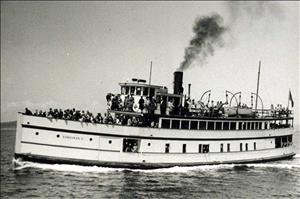Before Washington's state highway system was established, water transport was essential to commerce and public transportation on Puget Sound. The hundreds of small, independent, privately owned vessels of the "Mosquito Fleet" were built and operated to meet this need. Virginia V is the last surviving wooden-hull, steam-powered, passenger vessel on the West Coast. Built by Matthew Anderson on the beach at Maplewood, Pierce County, Virginia V was launched on March 9, 1922. She was the last of a line of working steamers all bearing the name "Virginia," owned and operated by the West Pass Transportation Company. Virginia V was and is still equipped with the 1898 triple expansion reciprocating steam engine built by Heffernan Iron Works of Seattle, an engine that was originally fitted into her predecessor, Virginia IV.
320,000 Miles Without Mishap
Virginia V originally operated out of the Tacoma Municipal Dock on what is now known as the Thea Foss Waterway. She provided daily passenger and freight service between Tacoma and Seattle, serving the small communities along the Colvos Passage route. Besides providing passenger and freight service, she delivered the mail and transported thousand of children to Camp Sealth for summer fun on Vashon Island. By 1933, Virginia V, or the "V" or "Ginny" as she was affectionately known, had logged 320,000 miles without a mishap on the route.
The vessel was severely damaged in a storm while docking at the Ollala dock on Sunday, September 21, 1934. This storm claimed the lives of 18 people and caused millions of dollars of damage in the Puget Sound area. Virginia V was beaten against the dock by 70 mph winds. The starboard side of the vessel's superstructure and a portion of the upper deck below the pilot house collapsed. The damage was estimated at $11,000, although no injuries to the crew or passengers were reported. The vessel was repaired at Lake Washington Shipyards at Houghton; work was completed in December 1934.
Auto Competition
The increased use of automobiles, trucks, and auto-ferries, and the resulting loss of passengers and freight, caused Virginia V to be laid up between January 1938 and April 1939. The company was suffering financially and saw profitable trade only during the ferry strikes of 1937 and 1939.
During the summer of 1940, the company shifted its base of operations to Seattle's Pier 3 and attempted to re-establish the traditional Seattle to Tacoma run. The route was down the east passage to Tacoma and the return each evening was via her traditional Colvos Passage run. Also during 1940, the Army contracted with the company to provide holiday leave excursions from Fort Casey, Fort Worden, and Fort Flagler to Seattle.
Early in 1942, the West Pass Transportation Company took the vessel to the Columbia River to carry freight and passengers between Portland and Astoria, Oregon. Virginia V is reputed to have been the last commercial steamboat to operate on the Columbia. However, by mid-year, the company had sustained large debts, and liens against the vessel brought about her seizure by a United States Marshall in August 1942. This seizure may have prevented her from being scrapped for war materials.
Virginia V was sold at a sheriff's sale to O. H. (Doc) Freeman and J. F. (Joe) Boles, who sold the vessel to Jack Katz and Captain Howell Parker in December 1943. Captain Parker brought the vessel back to Puget Sound in February 1944, where she was inspected and overhauled. Parker and his wife ran Virginia V on the Seattle-Tacoma route during the summers of 1944, 1945, and 1946. By 1946, post-war prosperity saw increased highway construction and auto traffic, resulting in less revenue on the Seattle-Tacoma route. During the late 1940s the Parkers shifted their emphasis to the excursion trade. Until 1953 they operated Virginia V on a route that extended north to the San Juan Islands and south to Olympia at the southern end of Puget Sound.
In 1948, the vessel was chartered by the Bainbridge Island Chamber of Commerce to provide transportation service to Bainbridge Island during a service lapse due to a workers' strike against the Puget Sound Navigation Company's Black Ball Line. The Black Ball Line was later (in 1951) sold to the state of Washington, as a result of the company's financial difficulties. Also during 1948, Virginia V was the winner of the last screw-powered steamboat race on Puget Sound (although the sternwheelers, also steamboats, W. T. Preston, Skagit Belle and Skagit Chief raced into the 1950s).
Changing Hands
The Parkers sold Virginia V to Philip Luther of the Puget Sound Excursion Lines in January 1954. Luther sold the vessel in 1956, to Captain Charles McMahon, who extensively overhauled the superstructure. In 1958, James F. (Cy) Devenny bought Virginia V and operated her with other vessels in the Puget Sound Excursion Line, primarily to an amusement park at the site of old Fort Ward, Bainbridge Island, on Rich Passage. In 1968, Northwest Steamship Company purchased the vessel for charters and excursions until the ownership was transferred in 1980 to the present owner, the Steamer Virginia V Foundation, a non-profit corporation.
The United States Secretary of the Interior designated Virginia V a National Historic Landmark on September 5, 1992. She was first listed on the United States National Register of Historic Sites in 1973, became a Seattle City Landmark in 1974, and a City of Tacoma Landmark in 1998. The vessel was restored at Lake Union Drydock in Seattle, and was rededicated in May 2002. She has been in full operation since then. She is a historic treasure for the entire country, and especially for the maritime communities of Puget Sound. The Virginia V is docked adjacent to the Museum of History and Industry (MOHA) on South Lake Union.

